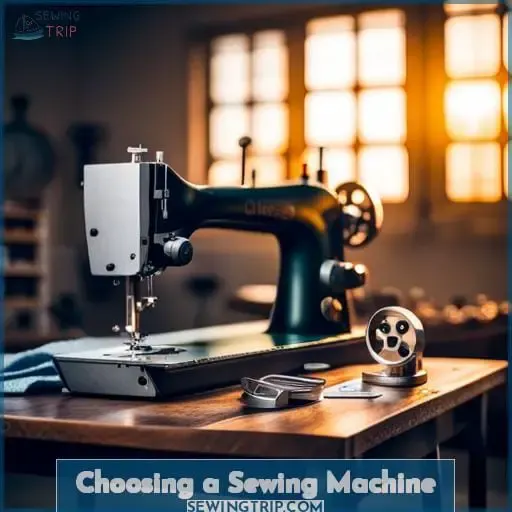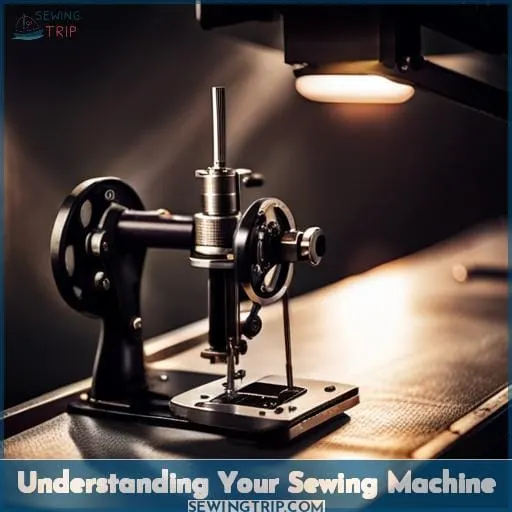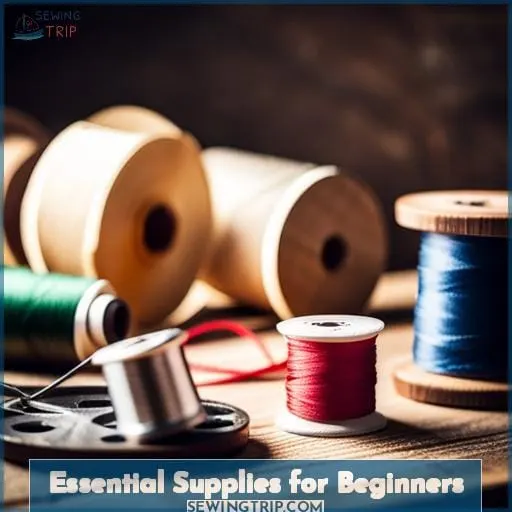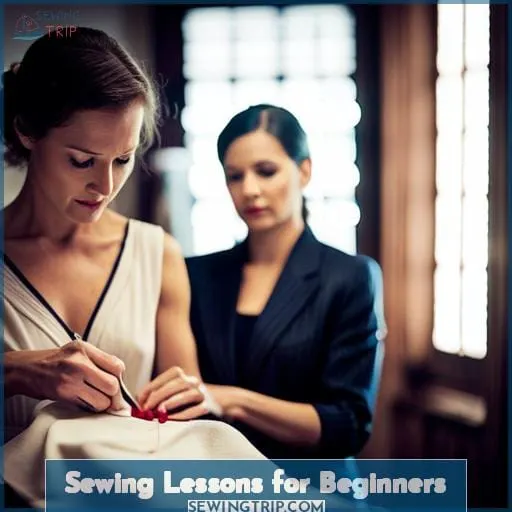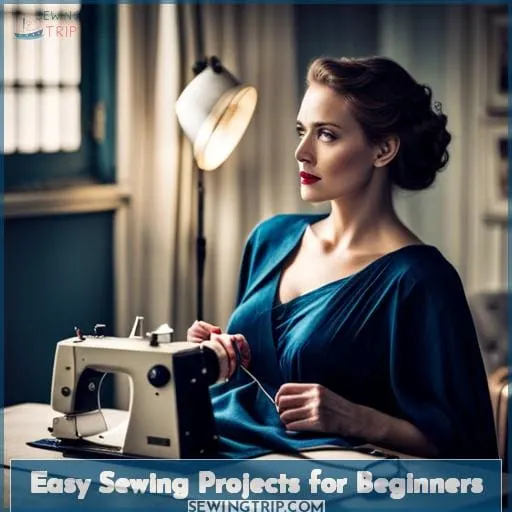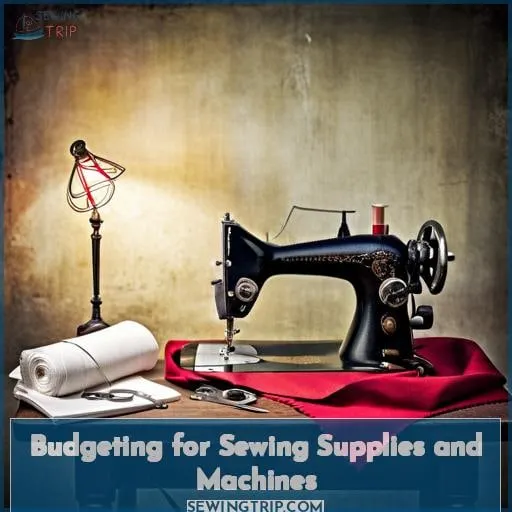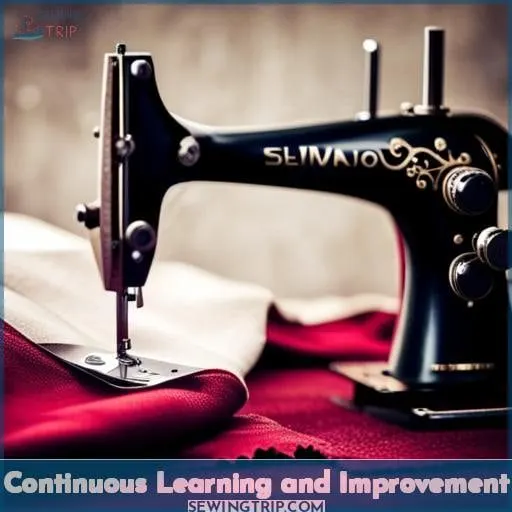This site is supported by our readers. We may earn a commission, at no cost to you, if you purchase through links.
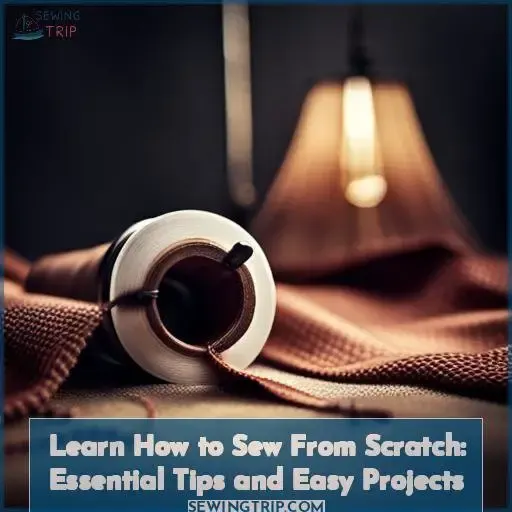 Imagine the feeling of taking a piece of fabric and transforming it into something beautiful, all with your own two hands. The power to create stunning garments and unique home decor is within your grasp.
Imagine the feeling of taking a piece of fabric and transforming it into something beautiful, all with your own two hands. The power to create stunning garments and unique home decor is within your grasp.
In this article, you will discover essential tips and easy projects that will guide you on how to sew from scratch. Whether you’re a beginner or looking to enhance your sewing skills, get ready to embark on a liberating journey filled with creativity and mastery.
Let’s dive in!
Table Of Contents
- Key Takeaways
- Choosing a Sewing Machine
- Understanding Your Sewing Machine
- Essential Supplies for Beginners
- Sewing Lessons for Beginners
- Easy Sewing Projects for Beginners
- Budgeting for Sewing Supplies and Machines
- Continuous Learning and Improvement
- Importance of Patience and Practice
- Finding Community and Support
- Frequently Asked Questions (FAQs)
- Conclusion
Key Takeaways
- Consider budget and feature preferences
- Read the user manual for a comprehensive understanding
- Gather basic supplies like fabric, thread, pins, scissors, and bobbins
- Join online sewing communities for support and guidance
Choosing a Sewing Machine
When it comes to choosing a sewing machine, there are several factors you need to consider.
First and foremost, determine your budget and decide whether you want a basic machine or one with more features.
Next, think about where you want to purchase your sewing machine – locally for potential free lessons or online for better prices.
Finally, do some research on specific machines that align with your needs and invest in one that you’ll love using for years to come.
Consider Your Budget and Needs
When choosing a sewing machine, consider your budget and needs.
Research options to find the best fit for you.
Decide between buying locally or online.
Look for machine features that suit your requirements and make a long-term investment in a machine you’ll love.
Decide Between Buying Locally or Online
If you’re ready to choose a sewing machine, it’s time to decide whether you want to buy locally or online.
Consider pricing considerations, learning options, and the benefits of in-person assistance versus online resources.
Determine if You Want a Basic or Feature-rich Machine
To determine if you want a basic or feature-rich machine when choosing a sewing machine, consider your specific needs and preferences.
Think about:
- Budget considerations
- Machine features
- Whether to buy locally or online
Remember that it’s a long-term investment that should accommodate your evolving needs as you learn to sew.
Research Specific Machine Options
Now that you have determined whether you want a basic or feature-rich machine, it’s time to research specific sewing machine options.
Compare brands, evaluate features, consider your budget and read user reviews for durability.
Invest in a Machine You’ll Love
Wondering how to choose a sewing machine that you’ll love?
When investing in a sewing machine, consider your needs and budget. Research different options and prioritize high-quality features for seamless garment making and easy projects.
Understanding Your Sewing Machine
Now that you have chosen your sewing machine, it’s time to understand how it works.
Start by reading the user manual for a comprehensive understanding of its features and functions.
Learn how to thread the machine properly, as this is essential for smooth stitching.
Take some time to familiarize yourself with the settings and buttons so that you can confidently set up your machine when needed.
Finally, make use of online tutorials and resources to further enhance your knowledge of sewing machine operation.
Read the User Manual
First, read the user manual to understand your sewing machine. This will boost your sewing confidence and help you navigate through machine settings and threading basics.
Supplement your learning with online tutorials for step-by-step guidance in crafting your handmade wardrobe.
Learn How to Thread the Machine
To thread your sewing machine, gather the necessary supplies and follow the step-by-step instructions provided in the user manual.
Here are some threading tips to help you get started:
- Familiarize yourself with different types of needles suitable for various fabric types.
- Positioning is key – make sure you align both upper and lower threads correctly through their respective guides before proceeding further.
- Utilize online resources such as sewing videos or tutorials that demonstrate effective needle-threading techniques step by step.
- If you encounter any difficulties while attempting to thread your machine, consult troubleshooting guides or seek assistance from fellow sewers who may have encountered similar challenges before.
Familiarize Yourself With Settings and Buttons
Now that you have learned how to thread the machine, it’s time to familiarize yourself with the settings and buttons on your sewing machine.
Understand their functions, learn how they work, and explore different settings for optimal results in your projects.
Practice Setting Up the Machine
Once you’ve familiarized yourself with the settings and buttons of your sewing machine, it’s time to practice setting up the machine.
- Threading the machine correctly
- Adjusting tension for different fabric types
- Selecting stitch options for various projects
- Familiarizing yourself with bobbin winding
Utilize Online Tutorials
Continue building your sewing machine knowledge by utilizing online tutorials to deepen your understanding of how to operate and make the most out of your sewing machine.
- Choose tutorials that offer effective learning.
- Explore various online resources.
- Focus on specific sewing techniques for skill advancement.
Essential Supplies for Beginners
As a beginner in sewing, it’s essential to gather the basic supplies that will set you up for success.
Start by gathering:
- Fabric
- Thread
- Pins
- Scissors
- Bobbins
These supplies will give you a solid foundation to begin your sewing journey.
As you advance and become more comfortable with sewing techniques, explore additional tools that can enhance your skills even further.
Don’t forget to consult a handy sewing dictionary to familiarize yourself with any unfamiliar terminology and learn about different fabric types for future projects.
And finally, follow a sewing pledge as a reminder of the key principles in your exciting new hobby or career path!
Gather Basic Sewing Supplies
To successfully start your sewing journey, gather the essential supplies for beginners.
Create a supplies checklist that includes:
- Fabric selection
- Sewing essentials like thread and pins
- Learning resources for beginner projects
Explore Additional Tools as You Advance
As you advance in your sewing skills, explore advanced tools to enhance your creativity and bring your projects to the next level.
Experiment with unique fabric selections, learn new sewing techniques, and incorporate creative embellishments for skill progression.
Consult a Sewing Dictionary
As you advance in your sewing skills, consult a sewing dictionary to understand unfamiliar terminology. Learn the language of fabrics, patterns, and techniques to empower yourself as a beginner.
Learn About Different Fabric Types
When exploring essential supplies for beginners in sewing, it’s important to learn about different fabric types.
Understanding fabric characteristics and choosing textiles wisely can elevate your sewing projects.
Consider the variety of fabrics available and their unique properties.
Follow a Sewing Pledge
Follow a sewing pledge to remind yourself of key principles in your sewing journey.
Set goals, stay committed, build skills, track progress, and celebrate achievements.
| Key Principles |
|---|
| Setting Goals |
| Staying Committed |
| Building Skills |
| Tracking Progress |
| Celebrating Achievements |
Sewing Lessons for Beginners
When starting your sewing journey from scratch, consider taking in-person lessons from local shops to gain hands-on experience and personalized guidance.
Seek the wisdom of experienced sewers, whether it’s a friend or family member with sewing skills or online mentors who can provide valuable insights.
Combine online tutorials with occasional help from a mentor for comprehensive learning and support.
Remember that patience is key as you practice and hone your sewing skills over time.
Consider In-person Lessons
Join a local sewing class to get:
- Hands-on instruction
- Guidance from experienced sewers
In-person lessons offer the opportunity for:
- Skill development
- A supportive environment
Learn alongside fellow beginners and receive:
- Personalized feedback
- On your projects
Embrace the learning process with:
- Hands-on guidance
- Knowledgeable mentors
Seek Guidance From Experienced Individuals
If you’re new to sewing and looking for guidance, seek out experienced mentors who can provide valuable lessons and support.
Connecting with individuals who’ve a wealth of knowledge in sewing can greatly improve your skills.
Joining sewing communities is another great way to find guidance and tips for your journey towards mastery.
Combine Online Lessons With Mentorship
Enhance your sewing skills by supplementing online lessons with the guidance and support of an experienced mentor.
Online mentorship can greatly accelerate your learning progress and help you improve your skills faster.
A mentor will provide:
- Valuable guidance
- Share their expertise
- Offer personalized feedback
Ensure you continue to develop as a sewist within the supportive sewing community.
Practice and Be Patient
Practice regularly and be patient with yourself as you embark on your sewing journey.
- Embrace mistakes as opportunities for learning and growth.
- Build confidence through consistent practice and skill improvement.
- Explore creative projects that inspire you to express your individuality.
- Enjoy the process of discovering new techniques and honing your sewing skills.
Easy Sewing Projects for Beginners
Now that you have learned the basics of sewing and are ready to start your first projects, it’s important to choose ones that will help build your confidence.
Begin with projects that involve straight lines for simplicity and choose ones with minimal embellishments or frills.
Household items like blankets, pillows, burp cloths, or key fobs make great beginner projects.
You can find easy sewing patterns online to guide you along the way as you gradually advance to more complex projects as your skills improve.
Start With Projects Involving Straight Lines
To begin your sewing journey as a beginner, start with simple projects that involve straight lines.
Choose the right thread for your project and explore stitch variations.
Consider different fabric choices, needle types, and tension adjustment techniques for optimal results.
Choose Projects With Minimal Embellishments
When starting out with sewing, choose projects with minimal embellishments for a more straightforward and beginner-friendly experience. Focus on honing your basic sewing techniques before diving into complex design inspiration.
- Explore fabric choices that are easy to work with
- Practice essential sewing techniques such as straight stitching and seam finishing
- Gain confidence in your skills before experimenting with intricate embellishment ideas
Consider Household Items as Beginner Projects
As you continue exploring easy sewing projects for beginners, consider starting with household items that require minimal embellishments. These practical entry-level creations are perfect for using beginner’s fabric and following easy sewing patterns.
Find Easy Sewing Patterns Online
If you frequently find yourself in need of easy sewing patterns and projects, you can easily search for them online.
- Explore websites like Pinterest for a wide variety of beginner-friendly patterns.
- Join online sewing communities to access pattern recommendations from experienced sewers.
- Utilize resources on popular sewing blogs or YouTube channels for step-by-step tutorials and project ideas
Gradually Advance to More Complex Projects
Now that you have mastered easy sewing projects, it’s time to take the next step and gradually advance to more complex projects.
Expand your skills by tackling projects with varying levels of complexity, building confidence as you navigate new learning curves.
Embrace project diversity and watch your skill progression soar.
Budgeting for Sewing Supplies and Machines
When it comes to sewing, budgeting for supplies and machines is essential.
Keep your budget in mind and look for deals and discounts when purchasing sewing tools and materials.
Prioritize necessary supplies, invest in quality tools that will last, and plan ahead for future needs as you continue on your sewing journey.
Keep Your Budget in Mind
Consider your budget when purchasing sewing supplies and machines.
Plan ahead, shop wisely, and save money by looking for deals and discounts.
Prioritize necessary supplies and invest in quality tools for cost-effective sewing.
Look for Deals and Discounts
When budgeting for sewing supplies and machines, it’s important to look for deals and discounts.
- Keep an eye out for sales at fabric stores or online retailers.
- Join sewing communities or forums where members often share discount codes or information about special promotions.
- Consider buying second-hand equipment, such as a pre-loved sewing machine, which can be significantly cheaper than purchasing brand new.
Prioritize Necessary Supplies
To prioritize necessary supplies for sewing on a budget, start by assessing what you already have and determine which items are essential to begin your sewing journey.
Focus on acquiring essential tools and quality materials while effectively managing your budget through smart shopping.
Invest in Quality Tools and Materials
To ensure the best results in your sewing projects, invest in quality tools and materials.
- Choose high-quality fabrics that suit your project.
- Invest in reliable sewing machines and accessories.
- Stock up on essential craft supplies for a seamless sewing experience.
Plan for Future Needs
As you continue your sewing journey, it’s important to plan for future needs by budgeting for sewing supplies and machines. Consider long-term needs, budget considerations, sustainable sewing practices, and the longevity of your equipment.
| Future Planning | Budget Considerations |
|---|---|
| Long-term Sewing Goals | Prioritize Necessary Supplies |
| Sustainable Sewing Practices | Look for Deals and Discounts |
| Equipment Longevity | Invest in Quality Tools and Materials |
Continuous Learning and Improvement
As you embark on your sewing journey, it’s important to remember that continuous learning and improvement are key.
Seek support and guidance from experienced sewers, whether through lessons, mentoring, or reaching out to family and friends who’ve sewing experience.
Practice regularly to improve your skills and be patient with yourself as you progress.
Start with simple projects and gradually tackle more complex ones as you gain confidence and experience in the art of sewing.
Seek Support and Guidance From Experienced Sewers
Join online sewing communities to connect with experienced sewers who can provide valuable support and guidance as you continue to learn and improve your sewing skills.
These mentorship benefits are essential for growth, allowing you access to:
- A supportive network
- Learning resources
- A community of like-minded individuals passionate about sewing.
Sewing communities offer the opportunity for continuous learning and improvement in your craft.
Practice Regularly to Improve Skills
How often should you practice sewing to improve your skills?
Regular practice is key to skill improvement and technique enhancement.
To embark on your mastery journey, challenge yourself with different sewing projects.
Dedicate consistent time for practicing and honing your sewing abilities, allowing yourself room for growth and improvement.
Be Patient With Yourself
You need to be patient with yourself as you continue to learn and improve your sewing skills.
Embrace mistakes as learning opportunities, building confidence along the way.
Sewing challenges are part of the creative exploration process that leads to skill progression.
Trust in your ability to grow and master this craft.
Gradually Tackle More Complex Projects
As you progress in your sewing skills, start taking on more challenging projects to further enhance your abilities.
- Increase the project complexity to match your skill progression.
- Experiment with challenging designs and advanced techniques.
- Explore the realm of creative sewing by pushing yourself beyond your comfort zone.
Importance of Patience and Practice
Now that you have embarked on your sewing journey, it’s important to understand that perfection takes time and practice.
Embrace the mistakes you make along the way as valuable learning opportunities, for they’ll ultimately contribute to your growth and improvement.
Be patient with yourself and your progress, allowing yourself the space to learn at your own pace.
Remember to enjoy every step of this beautiful journey of learning how to sew from scratch.
Understand That Perfection Takes Time
Improving your sewing skills requires patience and practice over time.
Embrace the journey of learning to sew, understanding that perfection takes time.
Don’t be discouraged by sewing mistakes; instead, see them as valuable learning opportunities.
Be patient with yourself and your progress, and enjoy the process of mastering this empowering skill.
Embrace Mistakes as Learning Opportunities
Don’t let mistakes discourage you – they’re valuable learning opportunities in your sewing journey.
Embracing mistakes allows for creative exploration and skill development.
Overcoming challenges through patience and practice is key to mastering the art of sewing.
So don’t be afraid to make a few stitches out of line, because every misstep brings you closer to becoming a confident sewer.
Be Patient With Yourself and Your Progress
Take your time and be patient with yourself as you learn how to sew from scratch.
Embrace mistakes as opportunities for growth and learning.
Building confidence in your sewing skills takes practice, but remember that each stitch improves your abilities.
Enjoy the creative exploration and find joy in the process of learning to sew.
Enjoy the Journey of Learning to Sew
Embrace the process of learning to sew and enjoy the journey as you develop your skills through practice and patience.
Finding inspiration in creative projects,
overcoming sewing challenges,
exploring fabric selection options,
and mastering stitch techniques will empower you on your path to sewing mastery.
Finding Community and Support
Looking to find a community of fellow sewing enthusiasts?
Join online sewing communities where you can connect with others who share your passion and exchange ideas, tips, and advice.
Additionally, consider attending local sewing groups or classes in your area to meet like-minded individuals and learn from experienced sewers.
Seek guidance from these seasoned experts who can provide invaluable support as you navigate your own sewing journey.
Don’t forget to share your creations with the community for feedback and inspiration while also offering encouragement to others along their own creative paths.
Join Online Sewing Communities
Connect with other sewing enthusiasts by joining online sewing communities.
Connect with beginners, share experiences, seek advice, explore projects, and build friendships.
These communities provide a supportive space to connect with like-minded individuals who can inspire and guide you in your sewing journey.
Attend Local Sewing Groups or Classes
Joining local sewing groups or classes is a great way to connect with fellow sewers and find support in your sewing journey.
Connect with local sewists,
Join sewing classes,
Share sewing experiences,
Learn from experts,
And enhance your skills.
Seek Guidance From Experienced Sewers
To enhance your sewing journey, seek guidance from experienced sewers who can provide valuable insights and tips.
Join sewing communities to connect with others on the same path, share skills, receive expert advice, and learn together.
Share Your Creations and Seek Feedback
When you share your sewing creations and seek feedback, you can:
- Connect with a supportive community of experienced sewers who offer guidance and inspiration.
- Engage in creative conversations, gain valuable insights, and improve your skills through community engagement.
Support and Inspire Others in Their Sewing Journey
As you continue your sewing journey, find inspiration and encouragement from a supportive community of fellow sewers.
Share your challenges and creative projects, while also learning from others’ experiences and skill sharing in the vibrant sewing community.
Frequently Asked Questions (FAQs)
How do I choose the right sewing machine for my needs and budget?
To choose the perfect sewing machine,
- Identify your budget and desired features.
- Research options that align with your needs.
What are some essential supplies I should have as a beginner sewer?
To embark on your sewing journey, gather essential supplies:
- Fabric
- Thread
- Pins
- Scissors
- Bobbins
As you advance in skills and creativity blossoms within you—explore more tools to elevate your craft.
Unleash the power of creation!
How can I find affordable sewing lessons or resources to learn how to sew?
Discover the realm of sewing mastery by seeking out cost-effective sewing lessons and resources.
Unleash your creative power with online tutorials, local community classes, or guidance from experienced sewers in your network.
Embrace liberation through the art of stitching!
What are some easy sewing projects that I can start with as a beginner?
As a beginner, start with easy sewing projects that empower you to master the craft.
Create simple yet stylish items like tote bags or throw pillows.
These projects will ignite your creativity and set you on the path to sewing mastery.
How do I budget for sewing supplies and machines without overspending?
To budget for sewing supplies and machines without overspending, prioritize practical purchases.
Plan your projects ahead to determine the necessary materials.
Seek sales or discounts, compare prices online, and consider second-hand options for machinery.
Masterful savings await!
Conclusion
To truly master the art of sewing from scratch, you must dive into the world of creativity and craftsmanship.
By choosing the right sewing machine, understanding its intricacies, and gathering essential supplies, you’ll be well on your way to creating stunning garments and home decor.
With practice, patience, and a willingness to learn, you can tackle easy sewing projects and gradually advance to more complex ones.
So, embrace the power of sewing from scratch and let your creativity soar!

